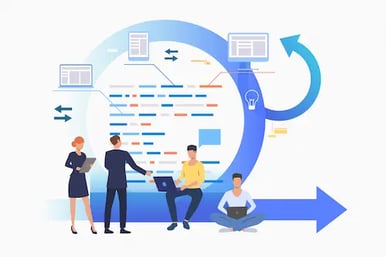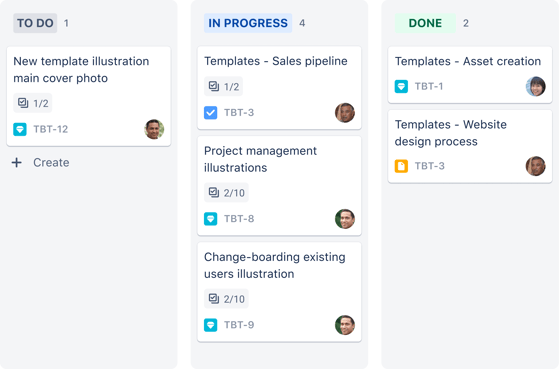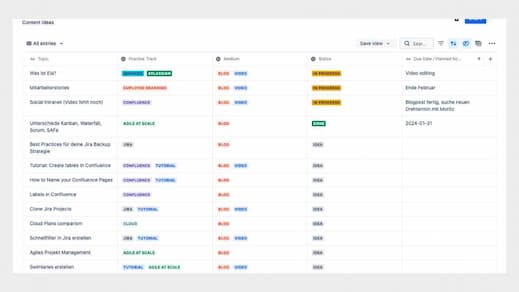4 min read
Agile Methods: Scrum vs. Kanban vs. SAFe® vs. LeSS
.jpeg) Stephanie Gaye
:
Jan 29, 2024 8:00:00 AM
Stephanie Gaye
:
Jan 29, 2024 8:00:00 AM
Agile is more than just a buzzword in modern software development and project management. It represents a set of principles and practices aimed at helping teams work together more efficiently and effectively. However, 'Agile' can look different depending on the context and implementation. In this post, we take a look at five different approaches: SAFe®, LeSS, Scrum, Waterfall, and Kanban.
 What exactly is agile work?
What exactly is agile work?
Agile is an approach where projects are divided into small units that are processed recurrently and in stages. This promotes closer team collaboration than with traditional working methods and ultimately allows for a swift and flexible response to changes. Customer opinions are also included in the project process, thus creating a continuous feedback loop. Structuring the work in sprints - these are short iterative development cycles (about a week to a month) - enables quick.
-
What are the basic principles of agile work?
-
Individuals and interactions over processes and tools: The goal is to employ and promote people to advance the project rather than focusing too heavily on rigid processes or tools.
-
Working software over comprehensive documentation: The focus is on developing software that meets the set requirements, rather than creating extensive and often outdated documentation.
-
Collaboration with the customer over contract negotiation: Continuous, close collaboration with customers is preferred in order to better understand and respond to their requirements.
-
Responding to change rather than following a plan strictly: Flexible adjustments to changes are a central component of agile work, as requirements and technologies often change.
-
Scrum
Scrum is an agile method that originally comes from software development. Unlike SAFe and LeSS, Scrum focuses more on individual teams. It is an agile management framework that emphasizes iterative and incremental work. It values bringing the team together daily and continuous improvement.
Scrum is particularly suitable for companies with simple organizational structures. Flat hierarchies simplify the process, yet within Scrum there are roles that help organize the project team. This structure promotes team collaboration and individual responsibility and allows teams to effectively respond to changing requirements.
Product Owner (PO) |
The Product Owner is responsible for maximizing the value of the product and the work of the Development Team. One of their main responsibilities is managing the Product Backlog. They determine which features are implemented in what order and are the main contact for questions and information about the product. |
Scrum Team |
The Scrum or Development Team consists of professionals who carry out the work to deliver a potential product increment at the end of each sprint. They self-organize and decide how to complete the work in the Sprint Backlog. The Development Team should be small, cross-functional, and self-sufficient. |
Scrum Master |
The Scrum Master acts as a facilitator and coach, ensuring that the team correctly applies Scrum principles and practices. They support the Development Team and the Product Owner and assists in removing obstacles that might prevent the Development Team from achieving |
-
An example for Scrum
A development team plans a two-week "sprint" in which it has selected specific tasks from the project backlog. The team meets daily for a 15-minute "Daily Scrum" to discuss progress and remove any obstacles. At the end of the sprint, the team presents the completed work and collects feedback.
SAFe® (Scaled Agile Framework)
SAFe® (Scaled Agile Framework) is an agile framework with a strong focus on the enterprise level. It is intended for large organizations that have multiple teams, departments, and stakeholders working together. SAFe synchronizes the alignment, collaboration, and delivery of many agile teams. It scales Scrum and Kanban at the enterprise level, incorporating portfolio management, program management, and team level.
At team level, SAFe® has the same roles as Scrum. Additional roles are added at the program and portfolio levels.
SAFe® Program Portfolio Management (PPM) |
This role is the highest decision-maker in a SAFe® environment. It articulates strategic objectives and concentrates investments on the most valuable work elements. |
Release Train Engineer (RTE) |
Der RTE ist der Scrum-Master für das Agile Release Train (ART), die primäre Wertlieferungskonstruktion von SAFe®. Der RTE ist verantwortlich für das Coaching der Teams in Agile und Scrum-Praktiken und für die Koordination der Teams für ein synchronisiertes Inkrement (Program Increment). |
Solution Management |
Solution Managers define capabilities and are responsible for multiple interacting areas (Agile Release Trains) concerning many stakeholder-based requirements and priorities in the underlying development value streams. |
Epic Owners |
Epic Owners are responsible for the definition, coordination, and communication of Epics (large, overarching initiatives) and for the impacts on the value stream and associated delivery structures. |
Product Management |
Essentially, Product Management in SAFe® corresponds to the role of the Product Owner in Scrum, but on a larger scale. |
System Architect/Engineer |
This role is responsible for managing and coordinating the technical standards and architectural governance beyond the train level. |
Business Owners |
Business Owners are key stakeholders who play an active role in product development and decision-making. |
-
An example for SAFe®
A large technology company with multiple teams in different locations uses SAFe to enable scaling and coordination. They plan their work in "programme increments", 8-12 week cycles where all teams work in sync. The company holds regular "Big Room Planning" sessions where representatives from all teams participate and plan the work for the next Programme Increment.
Have you heard about our certified SAFe® trainings?
Our experts train you in the appropriate methods, processes, and focuses of SAFe®. After participating in our trainings, you will be able to improve your company's agility and respond more efficiently to market fluctuations.
.webp?width=500&height=333&name=veniture%20mitarbeiterinnen%20(1).webp)
LeSS (Large Scale Scrum)
LeSS (Large Scale Scrum) is an agile framework that utilizes the principles of the Scrum framework and applies them to large teams in large organizations. It is designed to facilitate the scaling of Scrum by minimizing bureaucracy and allowing teams to focus on high-quality development work.
The roles in LeSS also align with those of Scrum. Unlike Scrum, some LeSS implementations scale up the roles to handle larger projects. For example, there may be multiple Product Owners (a main PO and Area POs) to handle the size and complexity of the product backlog. However, this is a rather atypical approach and is referred to as LeSS Huge.
-
An example for LeSS
An automotive company with multiple Scrum teams working on the same product implements LeSS. All teams share a product backlog and conduct a joint review and retrospective at the end of each sprint to share learnings and improvements.
Kanban
Kanban is an agile visual working method that emphasizes the visual organization of work. With Kanban, work is divided into discrete tasks and visualized on a Kanban board, making the workflow and bottlenecks easily recognizable. See what a Kanban board in Jira Work Management might look like.

-
An example for Kanban
An IT support team uses a Kanban board to visualise workflow and workload. They have columns for "To Do", "In Progress" and "Done". Each ticket or task is a card that moves through the columns. The capacity of each column is limited to avoid overload.
The choice of the right working method depends on the specific needs of your project or team. Whether it's a small, tightly linked team (Scrum, Kanban) or a large organization (SAFe, LeSS), the core of Agile remains the same: flexibility, communication, striving for continuous improvement, and high value creation.




